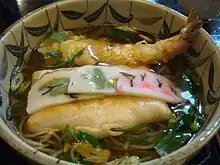Toshikoshi soba
Toshikoshi soba (年越し蕎麦) is a traditional Japanese noodle bowl dish eaten on ōmisoka (New Year's Eve, 31 December).[1]

Toshikoshi-soba(年越し蕎麦), soba-shop(蕎麦店), Tokyo, Japan.
This custom lets go of hardship of the year because soba noodles are easily cut while eating.
History
The custom differs from area to area and it is also called misoka soba, tsugomori soba, kure soba, jumyō soba, fuku soba, and unki soba.[2] The tradition started around the Edo period (1603-1867), and there are several traditions that long soba noodles symbolize a long life.[3] The buckwheat plant can survive severe weather during its growth period, and so soba represents strength and resilience.
See also
- Ōmisoka, the Japanese New Year's Eve
- Japanese cuisine
References
- Bill Daley, "New Year's Eve noodles: A savory end to the old year", Chicago Tribune
- In Japanese misoka, tsugomori, and kure all here designate New Year's Eve; jumyō means lifespan; fuku and unki both means happiness.
- Bill Daley, "A savory end to the old year: Soba caps busy New Year's Eve", December 29, 2010, Chicago Tribune
This article is issued from Wikipedia. The text is licensed under Creative Commons - Attribution - Sharealike. Additional terms may apply for the media files.
